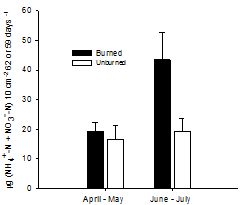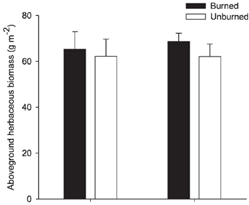Research Applications
Steppe ecosystems commonly experienced fire disturbance prior to settlement. There is concern that prescribed burning in these ecosystems could reduce forage production for livestock or promote establishment of invasive species.
Augustine et al. (2010) examined the effects of prescribed fire and grazing on herbaceous plant production and N bioavailability in shortgrass steppe. The study area, located in Pawnee National Grassland, was grazed annually for 10 years and then burned. Bioavailable soil N (NO3- and NH4+) was measured with PRS® Probes for 4 months immediately following burning. Burning did not immediately affect bioavailable soil N, but resulted in higher bioavailable soil N three months after burning (p=0.04) (Fig. 1). The aboveground herbaceous production of dominate vegetation, blue grama (Bouteloua gracilis) and buffalograss (Buchloe dactyloides), was not affected by burning during dormancy and subsequent grazing (Fig. 2).
 Figure 1. Soil inorganic nitrogen availability (mean ± 1 SE) in burned and unburned treatments on the Pawnee National Grassland, Colorado, during April-July 2007. PRS® probe burial in April-May = 62 days and June-July = 59 days.
Figure 1. Soil inorganic nitrogen availability (mean ± 1 SE) in burned and unburned treatments on the Pawnee National Grassland, Colorado, during April-July 2007. PRS® probe burial in April-May = 62 days and June-July = 59 days. Figure 2. Effects of burning and grazing on current-year production of aboveground herbaceous biomass production during 2008 on the Pawnee National Grassland, Colorado.
Figure 2. Effects of burning and grazing on current-year production of aboveground herbaceous biomass production during 2008 on the Pawnee National Grassland, Colorado.Examples
- Carbon and nitrogen decoupling under an 11-year drought in the shortgrass steppe
- Response of soil microbial activity to grazing, nitrogen deposition, and exotic cover in a serpentine grassland
- Soil-mediated effects of subambient to increased carbon dioxide on grassland productivity
- Effects of sheep grazing on availability and leaching of soil nitrogen in low-alpine grasslands
- Nitrogen partitioning between microbes and plants in the shortgrass
- Legumes mitigate ecological consequences of a topographic gradient in a northern Mongolian steppe
- Are there benefits to mowing Wyoming big sagebrush plant communities? An evaluation in southeastern Oregon
- Carbon controls on nitrous oxide production with changes in substrate availability in a North American Grassland
